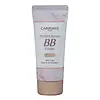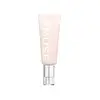What's inside
What's inside
 Key Ingredients
Key Ingredients

 Benefits
Benefits

 Concerns
Concerns

 Ingredients Side-by-side
Ingredients Side-by-side

Butylene Glycol
HumectantGlycerin
HumectantPropanediol
SolventDiglycerin
HumectantAscorbyl Glucoside
AntioxidantArbutin
AntioxidantCeramide NP
Skin ConditioningGlycosyl Trehalose
Emulsion StabilisingHydrogenated Starch Hydrolysate
HumectantMarrubium Vulgare Extract
Skin ConditioningHydrolyzed Prunus Domestica
Skin ConditioningHydrolyzed Silk
HumectantSaxifraga Sarmentosa Extract
Skin ConditioningGinkgo Biloba Leaf Extract
Skin ConditioningPrunus Yedoensis Leaf Extract
Skin ConditioningHamamelis Virginiana Leaf Extract
Skin ConditioningRosa Multiflora Fruit Extract
MaskingBetula Alba Bark Extract
MaskingChondrus Elatus/Saccharina Angustata/Monostroma Nitidum Thallus Extract
Skin ConditioningSodium Hyaluronate
HumectantPrunus Persica Leaf Extract
EmollientRoyal Jelly Extract
Skin ConditioningGlycine Soja Seed Extract
Skin ConditioningCoix Lacryma-Jobi Ma-Yuen Seed Extract
Skin ConditioningSoluble Collagen
HumectantVaccinium Myrtillus Leaf Extract
AstringentCynara Scolymus Leaf Extract
Skin ConditioningSqualane
EmollientC13-15 Alkane
SolventButylene Glycol, Glycerin, Propanediol, Diglycerin, Ascorbyl Glucoside, Arbutin, Ceramide NP, Glycosyl Trehalose, Hydrogenated Starch Hydrolysate, Marrubium Vulgare Extract, Hydrolyzed Prunus Domestica, Hydrolyzed Silk, Saxifraga Sarmentosa Extract, Ginkgo Biloba Leaf Extract, Prunus Yedoensis Leaf Extract, Hamamelis Virginiana Leaf Extract, Rosa Multiflora Fruit Extract, Betula Alba Bark Extract, Chondrus Elatus/Saccharina Angustata/Monostroma Nitidum Thallus Extract, Sodium Hyaluronate, Prunus Persica Leaf Extract, Royal Jelly Extract, Glycine Soja Seed Extract, Coix Lacryma-Jobi Ma-Yuen Seed Extract, Soluble Collagen, Vaccinium Myrtillus Leaf Extract, Cynara Scolymus Leaf Extract, Squalane, C13-15 Alkane
Water
Skin ConditioningDibutyl Adipate
EmollientButylene Glycol
HumectantPropanediol
SolventTitanium Dioxide
Cosmetic ColorantGlycerin
HumectantPolyglyceryl-3 Methylglucose Distearate
EmulsifyingC12-15 Alkyl Benzoate
AntimicrobialNiacinamide
SmoothingPhenyl Trimethicone
Skin ConditioningPolysilicone-15
UV FilterMethylpropanediol
SolventTridecyl Trimellitate
Emollient1,2-Hexanediol
Skin ConditioningCetearyl Alcohol
EmollientEthylhexyl Triazone
UV AbsorberPanthenol
Skin ConditioningPentylene Glycol
Skin ConditioningPolysorbate 60
EmulsifyingPrunus Persica Fruit Extract
AbrasiveSimmondsia Chinensis Seed Oil
EmollientSodium Hyaluronate
HumectantBis-Ethylhexyloxyphenol Methoxyphenyl Triazine
Skin ConditioningGlyceryl Stearate
EmollientPolymethylsilsesquioxane
Polyglyceryl-2 Caprate
EmulsifyingPalmitic Acid
EmollientPolyacrylate Crosspolymer-6
Emulsion StabilisingPolyacrylate-13
Ammonium Acryloyldimethyltaurate/Vp Copolymer
Sucrose Stearate
EmollientEthylhexylglycerin
Skin ConditioningPolyisobutene
Sodium Stearoyl Glutamate
CleansingStearic Acid
CleansingAlumina
AbrasiveXanthan Gum
EmulsifyingSaccharomyces Ferment Filtrate
HumectantAdenosine
Skin ConditioningGlyceryl Caprylate
EmollientDisodium EDTA
Squalane
EmollientPolysorbate 20
EmulsifyingSorbitan Isostearate
EmulsifyingT-Butyl Alcohol
PerfumingDimethylsilanol Hyaluronate
HumectantHydrolyzed Sodium Hyaluronate
Skin ConditioningHydrolyzed Hyaluronic Acid
HumectantMyristic Acid
CleansingPotassium Hyaluronate
Skin ConditioningHyaluronic Acid
HumectantSodium Hyaluronate Crosspolymer
HumectantHydroxypropyltrimonium Hyaluronate
Sodium Hyaluronate Dimethylsilanol
HumectantSodium Acetylated Hyaluronate
HumectantTocopherol
AntioxidantParfum
MaskingCI 77492
Cosmetic ColorantCI 77491
Cosmetic ColorantCI 77499
Cosmetic ColorantWater, Dibutyl Adipate, Butylene Glycol, Propanediol, Titanium Dioxide, Glycerin, Polyglyceryl-3 Methylglucose Distearate, C12-15 Alkyl Benzoate, Niacinamide, Phenyl Trimethicone, Polysilicone-15, Methylpropanediol, Tridecyl Trimellitate, 1,2-Hexanediol, Cetearyl Alcohol, Ethylhexyl Triazone, Panthenol, Pentylene Glycol, Polysorbate 60, Prunus Persica Fruit Extract, Simmondsia Chinensis Seed Oil, Sodium Hyaluronate, Bis-Ethylhexyloxyphenol Methoxyphenyl Triazine, Glyceryl Stearate, Polymethylsilsesquioxane, Polyglyceryl-2 Caprate, Palmitic Acid, Polyacrylate Crosspolymer-6, Polyacrylate-13, Ammonium Acryloyldimethyltaurate/Vp Copolymer, Sucrose Stearate, Ethylhexylglycerin, Polyisobutene, Sodium Stearoyl Glutamate, Stearic Acid, Alumina, Xanthan Gum, Saccharomyces Ferment Filtrate, Adenosine, Glyceryl Caprylate, Disodium EDTA, Squalane, Polysorbate 20, Sorbitan Isostearate, T-Butyl Alcohol, Dimethylsilanol Hyaluronate, Hydrolyzed Sodium Hyaluronate, Hydrolyzed Hyaluronic Acid, Myristic Acid, Potassium Hyaluronate, Hyaluronic Acid, Sodium Hyaluronate Crosspolymer, Hydroxypropyltrimonium Hyaluronate, Sodium Hyaluronate Dimethylsilanol, Sodium Acetylated Hyaluronate, Tocopherol, Parfum, CI 77492, CI 77491, CI 77499
Alternatives
Ingredients Explained
These ingredients are found in both products.
Ingredients higher up in an ingredient list are typically present in a larger amount.
Butylene Glycol (or BG) is used within cosmetic products for a few different reasons:
Overall, Butylene Glycol is a safe and well-rounded ingredient that works well with other ingredients.
Though this ingredient works well with most skin types, some people with sensitive skin may experience a reaction such as allergic rashes, closed comedones, or itchiness.
Learn more about Butylene GlycolGlycerin is already naturally found in your skin. It helps moisturize and protect your skin.
A study from 2016 found glycerin to be more effective as a humectant than AHAs and hyaluronic acid.
As a humectant, it helps the skin stay hydrated by pulling moisture to your skin. The low molecular weight of glycerin allows it to pull moisture into the deeper layers of your skin.
Hydrated skin improves your skin barrier; Your skin barrier helps protect against irritants and bacteria.
Glycerin has also been found to have antimicrobial and antiviral properties. Due to these properties, glycerin is often used in wound and burn treatments.
In cosmetics, glycerin is usually derived from plants such as soybean or palm. However, it can also be sourced from animals, such as tallow or animal fat.
This ingredient is organic, colorless, odorless, and non-toxic.
Glycerin is the name for this ingredient in American English. British English uses Glycerol/Glycerine.
Learn more about GlycerinPropanediol is an all-star ingredient. It softens, hydrates, and smooths the skin.
It’s often used to:
Propanediol is not likely to cause sensitivity and considered safe to use. It is derived from corn or petroleum with a clear color and no scent.
Learn more about PropanediolSodium Hyaluronate is hyaluronic acid's salt form. It is commonly derived from the sodium salt of hyaluronic acid.
Like hyaluronic acid, it is great at holding water and acts as a humectant. This makes it a great skin hydrating ingredient.
Sodium Hyaluronate is naturally occurring in our bodies and is mostly found in eye fluid and joints.
These are some other common types of Hyaluronic Acid:
Learn more about Sodium HyaluronateSqualane is an emollient that helps the skin hold onto moisture. It's an oily liquid that occurs naturally in certain types of fish and plant oils.
Because squalane boosts hydration in the skin, it also comes with plenty of benefits: it is an antioxidant and can help fight free radicals and skin damage. Squalane is also found to have a detoxifying effect when applied.
Squalane comes from squalene, which occurs naturally within the sebum of our skin. It is one of the oils our skin produces to keep itself hydrated. Squalane is the hydrogenated version of squalene and has a longer shelf life.
Research shows that squalane is non-irritating (even at 100% concentration).
In general, it's a fantastic ingredient. It does a great job at hydrating the skin, and it's suitable for those with sensitive skin.
The source of squalane may impact malassezia / fungal acne. This is because olive oil derived squalane can contain impurities such as fatty acids and plant waxes. Sugarcane derived squalane is recommended for anyone with malassezia concerns.
Is squalane vegan?
This depends on the source. Squalane can be derived from both plants and animals. Most squalane used in skincare comes from plants.
Please note: the source of squalane is only known if disclosed by the brand. We recommend reaching out to the brand if you have any questions about their squalane.
Read more about squalene with an "e".
Is squalane an oil?
Squalane is often called an oil, but it’s technically not; it’s a hydrocarbon, meaning it’s only made of carbon and hydrogen, unlike true oils which are triglycerides made of fatty acids and glycerol.
The term “oil-free” isn’t regulated, so companies can define it however they want. Some exclude all oils, while others just avoid mineral oil or comedogenic oils.
While some people avoid oils thinking they cause breakouts, the right kind of oil (or oil-like ingredient like squalane) can actually help balance and hydrate your skin. It’s worth testing out simple oils or squalane to see what works best for your skin.
Learn more about Squalane